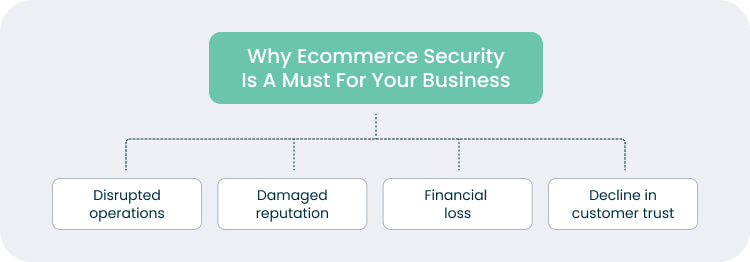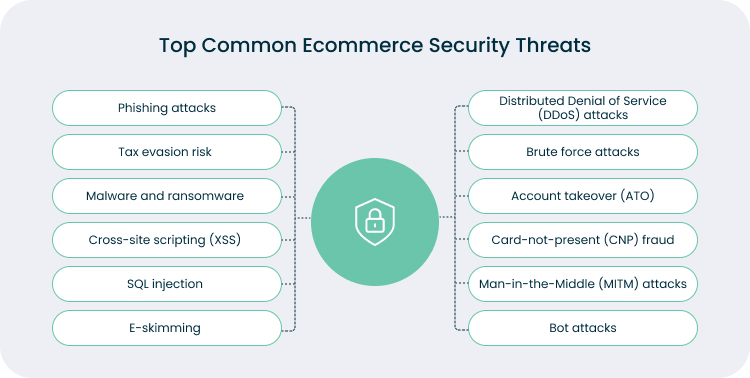In April 2025, retail giant Marks & Spencer (M&S) confirmed a massive cyberattack that disrupted operations and cost the company hundreds of millions of pounds. The ransomware attack was so serious that M&S told investors it could last for months and cut its yearly profit by about £300 million. That’s a wake-up call for every online business.
But the problem is, this isn’t a rare case. If a well-known brand like M&S can be hit hard, what about smaller companies that don’t have the same level of protection?
You’ve poured time, money, and heart into your online store. Yet a single data breach could undo months or even years of effort, damaging your reputation and customer trust. So, you see, a lot is at stake.
The good news: you don’t have to be a cybersecurity expert to keep your business safe. You just need the right knowledge and relevant measures.
That’s exactly what this article is about. We’ll share the ecommerce security best practices that work, helping you protect your store and customer data. Let’s dive in.
Why Ecommerce Security Is a Must for Your Business
You might think, “Cybercriminals usually go after big fish. Why would they target me?” Fair question. The truth is: not every company becomes a victim of a cyberattack. But you never know when it might be your turn. And if it does happen, it can hurt far more than you expect.
Don’t take your business’s value for granted. Even a small online store holds what hackers crave most: sensitive data, transaction details, and access to financial systems. And once you lose control of those, you put your clients at risk.
According to Statista, global losses from online payment fraud reached $44 billion in 2024 and are projected to surpass $100 billion by 2029. The numbers speak for themselves: security issues in ecommerce can cost you both money and reputation.
So, let’s break down why you can’t afford to overlook ecommerce security:
Disrupted operations
If your online store is vulnerable, cyberattacks can paralyze your operations and lead to costly data breaches. Orders may stop processing, websites can go offline, and support teams get overwhelmed with complaints. As a result, recovery takes time and resources.
As we mentioned earlier, Marks & Spencer faced a ransomware attack that caused serious disruptions and website outages. Customers had trouble shopping online. That’s why ecommerce security is about keeping your business alive and your customers loyal.
Damaged reputation
If an attack leads to the exposure of customer data, your brand’s reputation is under threat. And once trust is lost, it’s very hard to win it back.
For example, in 2025, hackers stole sensitive data from 430,000 Harrods’ customer records through a third-party provider. Even though payment details weren’t leaked, the incident still damaged the brand’s image.
Financial loss
Cyberattacks are expensive for any online store. Costs can add up quickly, including ransom payments, legal fees, downtime, data recovery, and regulatory fines.
In 2025, both M&S and Co-op UK were hit by large-scale cyberattacks. Together, both companies lost around £270 million ($363 million). This shows just how costly cyberattacks can be, even for recognized retailers.
Decline in customer trust
Customers who care about security won’t risk their sensitive data twice. One breach is often enough to make loyal buyers leave, and many never come back.
A study in the Sustainability Journal showed that customer trust drops after a data breach in online shopping. Many shoppers switch to other platforms and spend less, especially when companies don’t communicate openly about what happened.
So, as you can see, you can’t afford to ignore ecommerce security. The consequences go far beyond downtime or customer data loss. Real-world cases prove one thing: those who protect their online stores stay protected. It’s always better to invest in strong security measures now than to gamble with your business later.
Most Common Ecommerce Security Issues You Should Know
Now that you understand why ecommerce security matters, let’s look at the most common threats businesses face. We’ve put together a list of key risks so you can recognize them early and apply the right security practices to keep your online store safe.
- Phishing attacks: Hackers often send fake emails, messages, or create similar websites to trick people into sharing their passwords, payment details, or personal information. This can cause financial losses and quickly destroy customer trust.
- Tax evasion risk: Because online payments move electronically, some transactions can be harder to track. So, dishonest sellers can underreport income and avoid taxes.
- Malware and ransomware: Malware can damage your systems or steal sensitive data. Ransomware locks your files until you pay to get them back, but there’s no guarantee you will. Both can stop your business in its tracks and cost you time and money.
- Cross-site scripting (XSS): In this attack, hackers inject malicious code into your website, often using JavaScript. It lets them steal user data or redirect shoppers to fake, harmful sites. And of course, it can damage trust in your brand.
- SQL injection: Attackers insert malicious code into your database to get or change information. This exposes customer names, addresses, and payment info. So, in this case, data breaches and compliance risks are quite common.
- E-skimming: Hackers can plant malware in your online store or POS system to steal credit card details during checkout. The stolen data is then used for fraudulent purchases, which can cost you both money and reputation.
- Distributed Denial of Service (DDoS) attacks: DDoS attacks overwhelm your online store with fake traffic, blocking real shoppers from getting in. The result? Downtime, lost sales, and frustrated customers.
- Brute force attacks: Hackers try endless password combinations until one works. Once they’re in, they can take over accounts, leak data, and drain your funds.
- Account takeover (ATO): This happens when hackers get full access to a user or employee account, often through phishing. They can steal sensitive data, make fake purchases, or lock out the real owner.
- Card-not-present (CNP) fraud: Criminals use stolen credit card details to buy online. It leads to chargebacks, financial losses, and a blow to your brand’s credibility.
- Man-in-the-Middle (MITM) attacks: Hackers intercept the connection between a shopper and your site to steal payment info or login details. So, it puts your customers’ safety and your reputation at risk.
- Bot attacks: Bots can scrape prices, steal credentials, or mess with your inventory. They slow down your store and affect customer experience.
As you can see, many dangers can await your online store. And if your customers trust you with their sensitive information, you have no right to let them down. You’re responsible for keeping their data secure. That’s why your task is to choose the right ecommerce security measures to protect your audience from cyber thieves and make them feel safe when shopping at your store.
Proven Ecommerce Security Practices from Forbytes
Yes, we’ve already discussed why ecommerce security is a must for your business and looked at the most common threats that can hit your online store. Now it’s time for the most important part: how to protect your system from cybercriminals and keep sensitive data safe.
As you’ve noticed, hackers don’t sleep. They innovate just as fast as the most advanced companies. That’s why your security measures should be the same smart, complex, and adaptive.
Choose a secure ecommerce platform
Choosing the right ecommerce platform is one of the most important security steps you can take. A reliable platform should include PCI compliance, SSL certificates, multi-factor authentication (MFA), and automatic security updates to protect customer data and keep your store safe. Magento, Shopify, and BigCommerce are great options that are secure enough.
Advantages: A secure platform provides built-in protection against common threats. So, you can reduce your workload and give customers confidence when shopping.
Limitations: Some platforms may limit customization or require higher costs for advanced security features. So, make sure the solution fits both your budget and needs.
Use multi-layer security
First, we recommend using multi-layer security, as it combines several protection levels to strengthen your overall defense. One important layer is a Content Delivery Network (CDN) that blocks harmful traffic. Another important security measure is multi-factor authentication (MFA) for both employees and customers.
Advantages: Multi-layer security builds a stronger barrier against cyberattacks and lowers the risk of unauthorized access.
Limitations: Even with MFA, no online store is 100% secure. Hackers may still find ways to bypass protection, so don’t rely on this measure as your only line of defense.
Secure your website with SSL certificates
Make sure your ecommerce platform uses SSL certificates. They verify your website’s identity and encrypt data between your site and users. So, payment details and personal information are kept safe from hackers.
Advantages: SSL certificates protect sensitive data, build customer trust, and show users that your site is safe to shop on.
Limitations: SSL certificates need to be renewed regularly as expired ones can cause warnings that scare customers away.
Use anti-malware software
Protect your systems with reliable anti-malware software that detects and blocks malicious programs before they cause harm. It helps keep your online store safe from hidden threats like credit card hacks, spam, and redirects.
Advantages: Anti-malware tools provide round-the-clock protection, detect threats early, and prevent major damage to your website and data.
Limitations: Some malware can still slip through, especially if the software isn’t regularly updated, or scans aren’t automated.
Conduct regular security audits and vulnerability scanning
Regular security audits and vulnerability scans help identify weaknesses in your ecommerce systems, from outdated software to hidden security flaws. By running these checks, you can fix issues before they turn into real threats and maintain continuous data protection.
Advantages: They help uncover potential risks early, strengthen your overall security, and ensure compliance with data protection standards.
Limitations: Audits take time. They’re not something you can rush. Sometimes, you’ll need outside experts or consultants to handle complex checks, which can add extra costs to your operations.
Train your staff and educate your clients
Cybersecurity starts with people: both your team and your customers. Make sure your employees know how to protect sensitive data, use strong passwords, and follow privacy regulations. A quick training session or regular reminders can go a long way in preventing costly mistakes.
At the same time, help your customers stay safe too. Encourage them to use unique, complex passwords and watch out for phishing scams. Sometimes, one careless click can open the door to attackers, so a little education can make a big difference for everyone’s security.
Advantages: Builds a strong security culture, reduces human error, and increases overall awareness among staff and customers.
Limitations: Training and education take time and consistency. Without regular updates, people tend to forget or ignore best practices.
With the right ecommerce security measures in place, you’re not just protecting your online store; you’re protecting your reputation. Every step you take toward stronger safety shows your clients that you care about their trust as much as their data. And here’s the thing: when customers feel safe, they stay loyal. Security builds confidence, and confidence keeps them coming back.
How Forbytes Approaches Ecommerce Security
Ecommerce security is the foundation of trust between you and your customers. When people feel safe shopping on your site, they buy more and tell others about you. But once you neglect your system’s safety, the damage can be fast and costly. A single data leak or downtime can crush your revenue and reputation overnight.
Cyber threats are growing every day, so now’s the time to stay ahead. Build a strong safety plan, train your team, and educate your customers on how to shop securely. Run regular audits to spot vulnerabilities before attackers do. In short, make security part of your business routine.
At Forbytes, we treat security as the backbone of every ecommerce project we deliver. Whether we’re building a new online store or modernizing an existing one, our experts test your platform’s safety, stability, and performance at every step.
Let’s make your ecommerce platform safer, faster, and stronger together.

Our Engineers
Can Help
Are you ready to discover all benefits of running a business in the digital era?

Our Engineers
Can Help
Are you ready to discover all benefits of running a business in the digital era?









